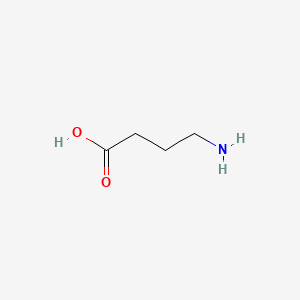4-aminobutyric acid
4-aminobutyric acid is a lipid of Fatty Acyls (FA) class. 4-aminobutyric acid is associated with abnormalities such as Epilepsy and Premenstrual syndrome. The involved functions are known as Binding (Molecular Function), neuron survival, Process, Uptake and physiological aspects. 4-aminobutyric acid often locates in Microglial, Neurofilament, Neuraxis, Brain region and Neurites. The associated genes with 4-aminobutyric acid are arginine methyl ester, SLC33A1 gene, NKS1 gene, P4HTM gene and ITSN2 gene. The related lipids are pregnenolone sulfate, pregnane-20-one, Pregnanes, Steroids and endogenous steroids.
Cross Reference
Introduction
To understand associated biological information of 4-aminobutyric acid, we collected biological information of abnormalities, associated pathways, cellular/molecular locations, biological functions, related genes/proteins, lipids and common seen animal/experimental models with organized paragraphs from literatures.
What diseases are associated with 4-aminobutyric acid?
4-aminobutyric acid is suspected in Premenstrual syndrome, Epilepsy and other diseases in descending order of the highest number of associated sentences.
Related references are mostly published in these journals:
| Disease | Cross reference | Weighted score | Related literature |
|---|
Possible diseases from mapped MeSH terms on references
We collected disease MeSH terms mapped to the references associated with 4-aminobutyric acid
PubChem Associated disorders and diseases
What pathways are associated with 4-aminobutyric acid
There are no associated biomedical information in the current reference collection.
PubChem Biomolecular Interactions and Pathways
Link to PubChem Biomolecular Interactions and PathwaysWhat cellular locations are associated with 4-aminobutyric acid?
Visualization in cellular structure
Associated locations are in red color. Not associated locations are in black.
Related references are published most in these journals:
| Location | Cross reference | Weighted score | Related literatures |
|---|
What functions are associated with 4-aminobutyric acid?
Related references are published most in these journals:
| Function | Cross reference | Weighted score | Related literatures |
|---|
What lipids are associated with 4-aminobutyric acid?
Related references are published most in these journals:
| Lipid concept | Cross reference | Weighted score | Related literatures |
|---|
What genes are associated with 4-aminobutyric acid?
Related references are published most in these journals:
| Gene | Cross reference | Weighted score | Related literatures |
|---|
What common seen animal models are associated with 4-aminobutyric acid?
There are no associated biomedical information in the current reference collection.
NCBI Entrez Crosslinks
All references with 4-aminobutyric acid
Download all related citations| Authors | Title | Published | Journal | PubMed Link |
|---|---|---|---|---|
| Carruthers NI et al. | Synthesis of a series of sulfinic acid analogs of GABA and evaluation of their GABAB receptor affinities. | 1998 | Bioorg. Med. Chem. Lett. | pmid:9873676 |
| McGraw T and Stacey BR | Gabapentin for treatment of neuropathic pain in a 12-year-old girl. | 1998 | Clin J Pain | pmid:9874016 |
| Bonanno G et al. | GABA(B) receptors as potential targets for drugs able to prevent excessive excitatory amino acid transmission in the spinal cord. | 1998 | Eur. J. Pharmacol. | pmid:9874164 |
| Kogo M et al. | Examination of the relationships between jaw opener and closer rhythmical muscle activity in an in vitro brainstem jaw-attached preparation. | 1998 | Somatosens Mot Res | pmid:9874519 |
| Czupryn A et al. | Neurotransmitter system markers in adult barrel field. | 1998 | Somatosens Mot Res | pmid:9874522 |
| Wickelgren I | Drug may suppress the craving for nicotine. | 1998 | Science | pmid:9874627 |
| Pernberg J et al. | Structure and dynamics of receptive fields in the visual cortex of the cat (area 18) and the influence of GABAergic inhibition. | 1998 | Eur. J. Neurosci. | pmid:9875339 |
| Gonzalez LE et al. | Stimulation of benzodiazepine receptors in the dorsal hippocampus and median raphé reveals differential GABAergic control in two animal tests of anxiety. | 1998 | Eur. J. Neurosci. | pmid:9875346 |
| Cattaert D and Le Ray D | Direct glutamate-mediated presynaptic inhibition of sensory afferents by the postsynaptic motor neurons. | 1998 | Eur. J. Neurosci. | pmid:9875352 |
| Brockhaus J and Ballanyi K | Synaptic inhibition in the isolated respiratory network of neonatal rats. | 1998 | Eur. J. Neurosci. | pmid:9875360 |
| Serrao M et al. | A case of myokymia-cramp syndrome successfully treated with gabapentin. | 1998 | Acta Neurol. Scand. | pmid:9875627 |
| Commons KG et al. | In the ventromedial nucleus of the rat hypothalamus, GABA-immunolabeled neurons are abundant and are innervated by both enkephalin- and GABA-immunolabeled axon terminals. | 1999 | Brain Res. | pmid:9878688 |
| Ikarashi Y et al. | Modulation of acetylcholine release via GABAA and GABAB receptors in rat striatum. | 1999 | Brain Res. | pmid:9878759 |
| Yan XX and Ribak CE | Alteration of GABA transporter expression in the rat cerebral cortex following needle puncture and colchicine injection. | 1999 | Brain Res. | pmid:9878808 |
| Feely M | Fortnightly review: drug treatment of epilepsy. | 1999 | BMJ | pmid:9880286 |
| Glitsch M and Marty A | Presynaptic effects of NMDA in cerebellar Purkinje cells and interneurons. | 1999 | J. Neurosci. | pmid:9880571 |
| Jin Y et al. | The Caenorhabditis elegans gene unc-25 encodes glutamic acid decarboxylase and is required for synaptic transmission but not synaptic development. | 1999 | J. Neurosci. | pmid:9880574 |
| Perrais D and Ropert N | Effect of zolpidem on miniature IPSCs and occupancy of postsynaptic GABAA receptors in central synapses. | 1999 | J. Neurosci. | pmid:9880578 |
| Collins DR and Paré D | Reciprocal changes in the firing probability of lateral and central medial amygdala neurons. | 1999 | J. Neurosci. | pmid:9880603 |
| Green AR et al. | Elevation of brain GABA concentrations with amino-oxyacetic acid; effect on the hyperactivity syndrome produced by increased 5-hydroxytryptamine synthesis in rats. | 1976 | J. Neural Transm. | pmid:988113 |
